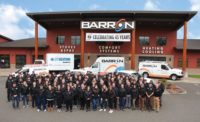WE DON'T NEED WIRELESS
Much of the HVAC industry has spent too much time in the technological dark ages. It is difficult, it seems, for the industry to keep up with some technologies (the Internet, global positioning satellites, blogs, and barcodes) that are more commonplace in other disciplines. The old way works and that is all we need, is a common sentiment among contractors, distributors, and manufacturers.According to Fein, productivity is imperative for distributors, however, "Distributors can only remain relevant if they continue to improve their productivity without compromising their service levels."
The U.S. distribution industry employs approximately one in every 20 workers. According to the webinar, the largest chunk of most warehouse budgets, roughly 41 percent, is spent on management, administration, and paperwork. This leaves a mere 59 percent of the budget for sales, transportation, warehousing, installation, repair, and staff.
The "but I'll have to reconstruct my entire warehouse" fear is just a myth. There is usually no need to tear down and build or buy a new warehouse. HVAC distributors that have ventured into the wireless warehouse world have found that although it takes time, money, and a little bit of hard work, the payoff is worth it.
Many who have implemented new technology are finding that not only does business productivity improve, but employee productivity also improves.

KEEP TRYING
Indiana Supply bit off a little more than it could chew when it installed a radio frequency (RF) warehouse system. The 88,000 square foot warehouse in Indiana employs 23 people with 12 of those picking 1,400 lines per day. With a desire to increase productivity, Indiana Supply jumped into a wireless warehouse with both feet. After changing the software side of the warehouse and the logistics side simultaneously, everything was chaos.According to Hasket, a lack of initial understanding created havoc. "You have to know what you want and what you are going to do with it [a wireless system]," said Hasket.
Along with trying too much at once, the employees entered all the warehouse barcodes on the fly. Unfortunately, the phrase "industry barcode standards" was found to be a misnomer. A vendor standard was what the company had to work with and many vendors had different standards. Needless to say the first attempt failed.
That didn't stop Hasket. He and his staff worked to fix the problems that had come up in the first attempt. After coming back online, the payoff came in the first year. With all the bugs worked out and the wireless warehouse system running well, Hasket reported a 90 percent cost reduction of errors, finding approximately $50,000 in mistakes the first year. The money saved from error reduction alone paid for the system in a brief few years, according to Hasket.
Other benefits came with the new system. According to Hasket, it helped in the overall personnel management creating a better culture in the warehouse. It also allowed the company to establish a service guarantee and protect itself from false claims of too much time spent in the supply house. Hasket found that it was also easier to establish and measure employee productivity.

SLOWLY BUT SURELY
The Granite Group took a different approach. The company decided to work on a two-step process. This 10,500-square-foot warehouse, with 28 employees and two shifts, couldn't find enough people to handle the warehouse workload. There was also too much time being spent on looking for product. According to Goff, accuracy was a major problem.In March of 2005, the receiving side of the warehouse began a dry run with wireless receiving. Goff's goal was to get the staff comfortable with the process. In June, The Granite Group brought the other half of the warehouse online. After about two weeks everything was working well and most of the kinks were out of the system, according to Goff. "I was surprised how easy it was," he said.
Now that the complete system has been working for a few months, Goff has found that warehouse inaccuracy is almost zero. He has also found that it is easier to train new employees. "It is easier to train people, a lot easier," said Goff. "Initial product knowledge is not necessary."
KEYS TO WIRELESS
"Don't do it all at once," said Hasket. It is important to identify exactly what is expected of the system.Along with pacing comes hard work. Every item has to have a barcode, and the items with multiple manufacturing barcodes must be reassociated. If the item is too small for a barcode, then it has to go on a shelf with a barcode or in a bin with a barcode.
Training is another key that affects wireless success. "The person who knows the most about the job is the one 20 feet away from it," said Hasket. "They are the ones you have to get on board." Goff ran small classes to train his employees. He also provided support the first week the system went live at The Granite Group. "This kills most problems," said Goff.
Preparation, training, and hard work are the keys necessary for wireless warehouse success, Hasket found that a wireless warehouse system impacts every process and procedure, making it easier to task and measure. "The people in our warehouse are happier," said Goff.
Publication date: 01/23/2006






